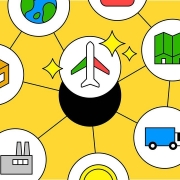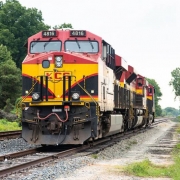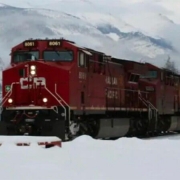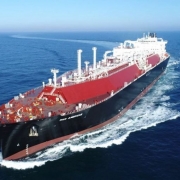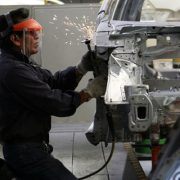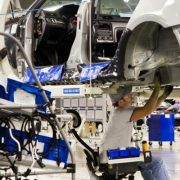CALGARY, Alberta & KANSAS CITY, Mo.–(BUSINESS WIRE)–Canadian Pacific Railway Limited (TSX: CP, NYSE: CP) (“CP”) and Kansas City Southern (NYSE: KSU) (“KCS”) today announced they have entered into a merger agreement, under which CP has agreed to acquire KCS in a stock and cash transaction representing an enterprise value of approximately USD$31 billion1, which includes the assumption of $3.8 billion of outstanding KCS debt. The transaction, which has the unanimous support of both boards of directors, values KCS at $300 per share, representing a 34% premium, based on the CP closing price on Aug. 9, 2021, the date prior to which CP submitted a revised offer to acquire KCS, and KCS’ unaffected closing price on March 19, 20212.
“Our path to this historic agreement only reinforces our conviction in this once-in-a-lifetime partnership,” said CP President and Chief Executive Officer Keith Creel. “We are excited to get to work bringing these two railroads together. By combining, we will unlock the full potential of our networks and our people while providing industry-best service for our customers. This perfect end-to-end combination creates the first U.S.-Mexico-Canada rail network with new single-line offerings that will deliver dramatically expanded market reach for CP and KCS customers, provide new competitive transportation options, and support North American economic growth.”
“We are glad to be partnering with CP to create a railroad that is able to compete by providing the best value for the transportation dollar,” said KCS President and Chief Executive Officer Patrick J. Ottensmeyer. “The CP-KCS combination will not only benefit customers, labor partners, and shareholders through new, single-line transportation services, attractive synergies and complementary routes, it will also benefit KCS and our employees by enabling us to become part of a growing and truly North American continental enterprise.”
While remaining the smallest of six U.S. Class 1 railroads by revenue, the combined company would have a much larger and more competitive network, operating approximately 20,000 miles of rail, employing close to 20,000 people, and generating total revenues of approximately $8.7 billion based on 2020 actual revenues. The CP-KCS combination is expected to create jobs across the joined network. Additionally, the companies expect efficiency and service improvements to achieve meaningful environmental benefits.
Transaction to Expand Options and Efficiencies for Customers
A CP-KCS combination would provide unprecedented reach via new single-line hauls across a combined network, offering:
- New single-line competitive options for domestic intermodal shipments between Mexico, the U.S. Midwest, and Canada, providing a truck competitive product for time-sensitive shipments in the high-value parts, perishables, and expedited markets.
- New single-line hauls linking key automotive manufacturing and distribution centers in Mexico, the U.S. Midwest, and Canada, capitalizing on CP’s best-in-class automotive compound network.
- New single-line routes linking energy, chemical, and merchandise shippers to more quickly and efficiently connect origin and destination facilities and reach new markets and global consumers.
- Unmatched access to Atlantic, Gulf, and Pacific ports, linking international intermodal shippers with North America’s largest consumer markets providing new optionality, capacity, and resiliency.
- New single-line routes allowing the efficient flow of agricultural products from CP’s origin-rich franchise to KCS’ destination-rich franchise, generating new optionality for shippers and receivers.
- Extended reach for short line and regional railroads coupled with new optionality for non-rail served customers via our extensive transload network.
Importantly, customers would not experience a reduction in independent railroad choices as a result of the transaction. CP-KCS have committed to keep all existing freight rail gateways open on commercially reasonable terms, while simultaneously competing aggressively to attract traffic via new single-line north-south lanes between Canada, the Upper Midwest and the Gulf Coast, Texas, and Mexico.
A CP-KCS combination would preserve the six-railroad structure of the North American Class 1 rail network: two in the west, two in the east and two in Canada, each with access to the U.S. Gulf Coast. The two companies once combined would remain the smallest of the Class 1 carriers.
Improving Highway Traffic, Environmental Sustainability, and Safety
The new single-line routes made possible by the transaction are expected to shift trucks off crowded U.S. highways, lowering emissions and reducing the need for public investments in road and highway bridge repairs. Rail is four times more fuel efficient than trucking, and one train can keep more than 300 trucks off public roads and produce 75 percent less greenhouse gas emissions. The synergies created by this combination are expected to take tens of thousands of trucks off the highways annually.
CP is committed to sustainability and is currently developing North America’s first line-haul hydrogen-powered locomotive. Additionally, the combined company would maintain both CP and KCS’ pledges to improve fuel efficiency and lower emissions in-line with the Paris Agreement to support a more sustainable North American supply chain.
Creating Value for KCS and CP Shareholders
Following the closing into a voting trust, common shareholders of KCS will receive 2.884 CP shares and $90 in cash for each KCS common share held. Preferred shareholders will receive $37.50 in cash for each KCS preferred share held. The fixed exchange ratio implies a price for KCS of $300 per share, representing a 34% premium, based on the CP closing price on August 9, 2021 and KCS’ unaffected closing price on March 19, 20213.
Immediately following the closing into trust, KCS common shareholders are expected to own 28 percent of CP’s outstanding common shares, providing the ability to participate in the upside of both companies’ growth opportunities. Following final regulatory approval by the U.S. Surface Transportation Board (“STB”), KCS shareholders would also reap the benefits of synergies resulting from the combination.
The combined growth strategies of the two fastest-growing Class 1s will result in new efficiencies for customers and improved on-time performance under their respective Precision Scheduled Railroading programs. The combined company is expected to create annualized synergies of approximately $1 billion over three years.
The combination is expected to be accretive to CP’s adjusted diluted EPS4 in the first full year following CP’s acquisition of control of KCS, and is expected to generate double-digit accretion upon the full realization of synergies thereafter.
To fund the stock consideration of the merger, CP will issue 44.5 million new shares. Consistent with the previously announced transaction, the cash portion will be funded through a combination of cash-on-hand and raising approximately $8.5 billion in debt, for which financing has been committed. As part of the merger, CP will assume approximately $3.8 billion of KCS’ outstanding debt. Following the closing into trust, CP expects that its outstanding debt will be approximately $20 billion.
Pro forma for the transaction, CP estimates its leverage ratio against 2021E street consensus EBITDA to be approximately 3.9x with the assumption of KCS debt and issuance of new acquisition-related debt. In order to manage this leverage effectively, CP will continue to temporarily suspend its normal course issuer bid program, and expects to produce approximately $7 billion of levered free cash flow (after interest and taxes) over the next three years. CP estimates its long-term leverage target of approximately 2.5x to be achieved within 24 months after closing into trust. The combined company will remain committed to maintaining strong investment grade credit ratings while continuing to return capital for the benefit of shareholders.
Strong Stakeholder Support for CP-KCS
More than 1,000 stakeholders – including railroad labor unions, shippers, and community leaders – have written letters to the STB supporting CP’s proposed combination with KCS. These letters emphasize the enhanced competition and unsurpassed levels of service, safety and economic efficiency that the transaction will bring for shippers and communities across the U.S., Mexico, and Canada that a CP-KCS combination offers.
Clear Path to Complete Transaction and Merger
On May 6, 2021, the STB approved the use of a voting trust for a planned CP-KCS merger, and the pertinent circumstances surrounding this new agreement between CP and KCS have not changed relative to those underlying the STB’s decision approving a trust. To close into voting trust, the transaction requires approval from shareholders of both companies along with satisfaction of customary closing conditions, including Mexican regulatory approvals. CP would then acquire KCS and place the KCS shares into the voting trust, at which point KCS shareholders would receive 2.884 CP shares and $90 in cash for each KCS common share held. The companies expect the transaction to close and KCS shareholders to receive their consideration in Q1 2022.
CP’s ultimate acquisition of control of KCS’ U.S. railways is subject to the approval of the STB. In April, the STB decided that it would review the CP-KCS combination under the merger rules in existence prior to 2001 and the waiver granted to KCS in 2001 to exempt it from the 2001 merger rules. In August, the STB reaffirmed that the pre-2001 rules would govern its review of the CP-KCS transaction.
The STB review of CP’s proposed control of KCS is expected to be completed in the second half of 2022. Upon obtaining control approval, the two companies will be integrated fully over the ensuing three years, unlocking the benefits of the combination.
Board, Management, and Headquarters
Following STB approval of the CP’s control of KCS, Mr. Creel will serve as the Chief Executive Officer of the combined company. The combined entity will be named Canadian Pacific Kansas City (“CPKC”).
Calgary will be the global headquarters of CPKC, and Kansas City, Missouri will be the U.S. headquarters. The Mexico headquarters will remain in Mexico City and Monterrey. CP’s current U.S. headquarters in Minneapolis-St. Paul will remain an important base of operations.
Four KCS Directors will join CP’s expanded Board at the appropriate time, bringing their experience and expertise in overseeing KCS’ multinational operations.
Advisors
BMO Capital Markets and Goldman Sachs & Co. LLC are serving as financial advisors to Canadian Pacific. Sullivan & Cromwell LLP, Bennett Jones LLP and the Law Office of David L. Meyer are serving as legal counsel. Creel, García-Cuéllar, Aiza y Enríquez, S.C. are serving as Mexican legal counsel to Canadian Pacific. Evercore is serving as the Canadian Pacific Board’s financial advisors and Blake, Cassels & Graydon LLP is serving as the Board’s legal counsel.
BofA Securities and Morgan Stanley & Co. LLC are serving as financial advisors to Kansas City Southern. Wachtell, Lipton, Rosen & Katz, Baker & Miller PLLC, Davies Ward Phillips & Vineberg LLP, WilmerHale, and White & Case, S.C. are serving as legal counsel to Kansas City Southern.
Conference Call for Investment Community
CP and KCS will host a joint investor conference call Thursday, Sept. 16, at 8 a.m. ET to discuss this announcement. A live webcast of the call and the replay will be available on the CP website at https://investor.cpr.ca/events and the KCS website at https://investors.kcsouthern.com/events-calendar. Supporting materials will be posted on www.FutureForFreight.com. To listen to the live conference call, dial (877) 830-2586 in the U.S. or (785) 424-1734 internationally, passcode 74335.
A conference call replay will be available for one week following the call and can be accessed by dialing (800) 753-5212 (no passcode needed).
For information on the benefits of a CP-KCS combination, visit FutureForFreight.com.
FORWARD LOOKING STATEMENTS AND INFORMATION
This news release includes certain forward looking statements and forward looking information (collectively, FLI) to provide CP and KCS shareholders and potential investors with information about CP, KCS and their respective subsidiaries and affiliates, including each company’s management’s respective assessment of CP, KCS and their respective subsidiaries’ future plans and operations, which FLI may not be appropriate for other purposes. FLI is typically identified by words such as “anticipate”, “expect”, “project”, “estimate”, “forecast”, “plan”, “intend”, “target”, “believe”, “likely” and similar words suggesting future outcomes or statements regarding an outlook. All statements other than statements of historical fact may be FLI.
Although we believe that the FLI is reasonable based on the information available today and processes used to prepare it, such statements are not guarantees of future performance and you are cautioned against placing undue reliance on FLI. By its nature, FLI involves a variety of assumptions, which are based upon factors that may be difficult to predict and that may involve known and unknown risks and uncertainties and other factors which may cause actual results, levels of activity and achievements to differ materially from those expressed or implied by these FLI, including, but not limited to, the following: the timing and completion of the transaction, including receipt of regulatory and shareholder approvals and the satisfaction of other conditions precedent; interloper risk; the realization of anticipated benefits and synergies of the transaction and the timing thereof; the success of integration plans; the focus of management time and attention on the transaction and other disruptions arising from the transaction; changes in business strategy and strategic opportunities; estimated future dividends; financial strength and flexibility; debt and equity market conditions, including the ability to access capital markets on favourable terms or at all; cost of debt and equity capital; potential changes in the CP share price which may negatively impact the value of consideration offered to KCS shareholders; the ability of management of CP, its subsidiaries and affiliates to execute key priorities, including those in connection with the transaction; general Canadian, U.S., Mexican and global social, economic, political, credit and business conditions; risks associated with agricultural production such as weather conditions and insect populations; the availability and price of energy commodities; the effects of competition and pricing pressures, including competition from other rail carriers, trucking companies and maritime shippers in Canada, the U.S. and Mexico; North American and global economic growth; industry capacity; shifts in market demand; changes in commodity prices and commodity demand; uncertainty surrounding timing and volumes of commodities being shipped; inflation; geopolitical instability; changes in laws, regulations and government policies, including regulation of rates; changes in taxes and tax rates; potential increases in maintenance and operating costs; changes in fuel prices; disruption in fuel supplies; uncertainties of investigations, proceedings or other types of claims and litigation; compliance with environmental regulations; labour disputes; changes in labour costs and labour difficulties; risks and liabilities arising from derailments; transportation of dangerous goods; timing of completion of capital and maintenance projects; sufficiency of budgeted capital expenditures in carrying out business plans; services and infrastructure; the satisfaction by third parties of their obligations; currency and interest rate fluctuations; exchange rates; effects of changes in market conditions and discount rates on the financial position of pension plans and investments; trade restrictions or other changes to international trade arrangements; the effects of current and future multinational trade agreements on the level of trade among Canada, the U.S. and Mexico; climate change and the market and regulatory responses to climate change; anticipated in-service dates; success of hedging activities; operational performance and reliability; customer, shareholder, regulatory and other stakeholder approvals and support; regulatory and legislative decisions and actions; the adverse impact of any termination or revocation by the Mexican government of Kansas City Southern de Mexico, S.A. de C.V.’s Concession; public opinion; various events that could disrupt operations, including severe weather, such as droughts, floods, avalanches and earthquakes, and cybersecurity attacks, as well as security threats and governmental response to them, and technological changes; acts of terrorism, war or other acts of violence or crime or risk of such activities; insurance coverage limitations; material adverse changes in economic and industry conditions, including the availability of short and long-term financing; and the pandemic created by the outbreak of COVID-19 and its variants, and resulting effects on economic conditions, the demand environment for logistics requirements and energy prices, restrictions imposed by public health authorities or governments, fiscal and monetary policy responses by governments and financial institutions, and disruptions to global supply chains.
We caution that the foregoing list of factors is not exhaustive and is made as of the date hereof. Additional information about these and other assumptions, risks and uncertainties can be found in reports and filings by CP and KCS with Canadian and U.S. securities regulators, including any proxy statement, prospectus, material change report, management information circular or registration statement to be filed in connection with the transaction. Reference should be made to “Risk Factors” and “Management’s Discussion and Analysis of Financial Condition and Results of Operations—Forward Looking Statements” in CP’s and KCS’s annual and interim reports on Form 10-K and 10-Q. Due to the interdependencies and correlation of these factors, as well as other factors, the impact of any one assumption, risk or uncertainty on FLI cannot be determined with certainty.
Except to the extent required by law, we assume no obligation to publicly update or revise any FLI, whether as a result of new information, future events or otherwise. All FLI in this news release is expressly qualified in its entirety by these cautionary statements.
ABOUT CANADIAN PACIFIC
Canadian Pacific is a transcontinental railway in Canada and the United States with direct links to major ports on the west and east coasts. CP provides North American customers a competitive rail service with access to key markets in every corner of the globe. CP is growing with its customers, offering a suite of freight transportation services, logistics solutions and supply chain expertise. Visit www.cpr.ca to see the rail advantages of CP. CP-IR
ABOUT KCS
Headquartered in Kansas City, Mo., Kansas City Southern (KCS) (NYSE: KSU) is a transportation holding company that has railroad investments in the U.S., Mexico and Panama. Its primary U.S. holding is The Kansas City Southern Railway Company, serving the central and south central U.S. Its international holdings include Kansas City Southern de Mexico, S.A. de C.V., serving northeastern and central Mexico and the port cities of Lázaro Cárdenas, Tampico and Veracruz, and a 50 percent interest in Panama Canal Railway Company, providing ocean-to-ocean freight and passenger service along the Panama Canal. KCS’ North American rail holdings and strategic alliances with other North American rail partners are primary components of a unique railway system, linking the commercial and industrial centers of the U.S., Mexico and Canada. More information about KCS can be found at www.kcsouthern.com.
ADDITIONAL INFORMATION ABOUT THE TRANSACTION AND WHERE TO FIND IT
CP will file with the U.S. Securities and Exchange Commission (SEC) a registration statement on Form F-4, which will include a proxy statement of KCS that also constitutes a prospectus of CP, and any other documents in connection with the transaction. The definitive proxy statement/prospectus will be sent to the shareholders of KCS. CP will also file a management proxy circular in connection with the transaction with applicable securities regulators in Canada and the management proxy circular will be sent to CP shareholders. INVESTORS, STOCKHOLDERS AND SHAREHOLDERS OF KCS AND CP ARE URGED TO READ THE PROXY STATEMENT/PROSPECTUS AND MANAGEMENT PROXY CIRCULAR, AS APPLICABLE, AND ANY OTHER DOCUMENTS FILED OR TO BE FILED WITH THE SEC OR APPLICABLE SECURITIES REGULATORS IN CANADA IN CONNECTION WITH THE TRANSACTION WHEN THEY BECOME AVAILABLE, AS THEY WILL CONTAIN IMPORTANT INFORMATION ABOUT KCS, CP, THE TRANSACTION AND RELATED MATTERS. The registration statement and proxy statement/prospectus and other documents filed by CP and KCS with the SEC, when filed, will be available free of charge at the SEC’s website at www.sec.gov. In addition, investors and shareholders will be able to obtain free copies of the registration statement, proxy statement/prospectus, management proxy circular and other documents which will be filed with the SEC and applicable securities regulators in Canada by CP online at investor.cpr.ca and www.sedar.com, upon written request delivered to CP at 7550 Ogden Dale Road S.E., Calgary, Alberta, T2C 4X9, Attention: Office of the Corporate Secretary, or by calling CP at 1-403-319-7000, and will be able to obtain free copies of the proxy statement/prospectus and other documents filed with the SEC by KCS online at www.investors.kcsouthern.com, upon written request delivered to KCS at 427 West 12th Street, Kansas City, Missouri 64105, Attention: Corporate Secretary, or by calling KCS’s Corporate Secretary’s Office by telephone at 1-888-800-3690 or by email at [email protected].
You may also read and copy any reports, statements and other information filed by KCS and CP with the SEC at the SEC public reference room at 100 F Street N.E., Room 1580, Washington, D.C. 20549. Please call the SEC at 1-800-732-0330 or visit the SEC’s website for further information on its public reference room. This news release shall not constitute an offer to sell or the solicitation of an offer to buy any securities, nor shall there be any sale of securities in any jurisdiction in which such offer, solicitation or sale would be unlawful prior to appropriate registration or qualification under the securities laws of such jurisdiction. No offering of securities shall be made except by means of a prospectus meeting the requirements of Section 10 of the U.S. Securities Act of 1933, as amended.
NON-GAAP MEASURES
Although this news release includes forward-looking non-GAAP measures (adjusted diluted EPS and earnings before interest, tax, depreciation and amortization (EBITDA)), it is not practicable to reconcile, without unreasonable efforts, these forward-looking measures to the most comparable GAAP measures (diluted EPS and Net income, respectively), due to unknown variables and uncertainty related to future results. Please see Note on forward-looking statements above for further discussion.
PARTICIPANTS IN THE SOLICITATION OF PROXIES
This news release is not a solicitation of proxies in connection with the transaction. However, under SEC rules, CP, KCS, and certain of their respective directors and executive officers may be deemed to be participants in the solicitation of proxies in connection with the transaction. Information about CP’s directors and executive officers may be found in its 2021 Management Proxy Circular, dated March 10, 2021, as well as its 2020 Annual Report on Form 10-K filed with the SEC and applicable securities regulators in Canada on February 18, 2021, available on its website at investor.cpr.ca and at www.sedar.com and www.sec.gov. Information about KCS’s directors and executive officers may be found on its website at www.kcsouthern.com and in its 2020 Annual Report on Form 10-K filed with the SEC on January 29, 2021, available at www.investors.kcsouthern.com and www.sec.gov. These documents can be obtained free of charge from the sources indicated above. Additional information regarding the interests of such potential participants in the solicitation of proxies in connection with the transaction will be included in the proxy statement/prospectus and management proxy circular and other relevant materials filed with the SEC and applicable securities regulators in Canada when they become available.
1 Except where noted, all figures are in U.S. dollars.
2 Based on KCS closing share price of $224.16 as of March 19, 2021 and CP closing share price of CAD$91.50 (at 1.2565 FX rate) as of Aug. 9, 2021.
3 Based on KCS closing share price of $224.16 as of March 19, 2021 and CP closing share price of CAD$91.50 (at 1.2565 FX rate) as of Aug. 9, 2021.
4 Accretion based on adjusted diluted EPS excluding one-time advisory, financing, and integration costs as well as incremental transaction-related amortization.



